Sick and tired of the constant struggle with algae on the aquarium glass? Keeping water in the clarity of a crystal-clear tank may sometimes be a challenge, especially with algae issues. The techniques widely used in cleaning are normally slow and, in this case, may not offer the desired results. This is where the magnetic glass cleaners for aquariums come in. So, let me introduce you to magnetic glass cleaners, their benefits and drawbacks, tips on how to use them properly, and some other useful tricks to remove algae from aquarium glass.
Content Table
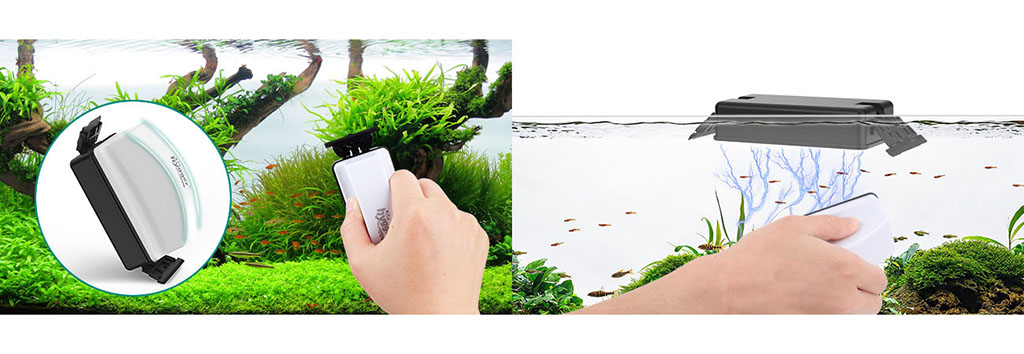
Cleaning aquarium glass
Magnetic Aquarium Glass Cleaner, Good or Bad
Magnetic aquarium glass cleaners are a widely used device by fish enthusiasts as they allow cleaning glass fish tanks easily. But, like any product, they both have their strengths and weaknesses.
Pros of Magnetic Aquarium Glass Cleaners
- Convenience: They break the need to scrub the surface physically, so time is saved and efforts are reduced.
- Safety: Chemicals and utensils that may hurt fish or plants are not required.
- Effectiveness: They can help scrub algae and other dirt along your tank walls and bottom.
- Suitable for large tanks: They can cover and work on large glass surfaces without any difficulties.
Cons of Magnetic Aquarium Glass Cleaners
- Initial cost: They can also cost more than the usual cleaning practices and techniques.
- Effectiveness depends on glass thickness: They may require better cutting on thicker or textured glass.
- Requires practice: This can prove quite challenging, and it may take some time for one to learn how to effectively use a magnetic cleaner.
- May not reach all corners: There are some sections of the tank like the corners and areas that can hardly be accessed by a magnetic cleaner.
How to Clean Aquarium Glass
Maintaining a clean aquarium glass is essential for the health of your fish and the overall appearance of your tank. Here are some effective methods for cleaning aquarium glass.
Inside the Tank
| Regular water changes | A significant part of keeping the glass clean is performing regular water changes. These changes remove excess nutrients and waste that can contribute to algae growth. |
| Use a siphon hose | When doing water changes, use a siphon hose to remove debris and algae from the bottom of the tank. This will help prevent these particles from sticking to the glass. |
| Algae scraper | For stubborn algae patches, gently use an algae scraper. Be careful not to scratch the glass. |
Outside the Tank
| Soft cloth or sponge | Use a soft cloth or sponge dampened with clean water to wipe the outside of the glass. Avoid harsh chemicals that can harm your fish and plants. |
| Magnetic glass cleaner | For larger tanks or more stubborn stains, a magnetic glass cleaner can be a convenient option. These tools have two magnetic sides, one inside and one outside the tank. As you move the outside magnet, the inside magnet scrubs the glass. |
Tips for Daily Maintenance:
- Prevent algae growth: Control factors that contribute to algae growth, such as excessive lighting, overfeeding, and high nutrient levels.
- Regular cleaning: Make it a habit to wipe the outside of the glass daily and clean the inside during water changes.
- Avoid harsh chemicals: Stick to gentle cleaning methods and avoid using harsh chemicals that can harm your aquarium inhabitants.
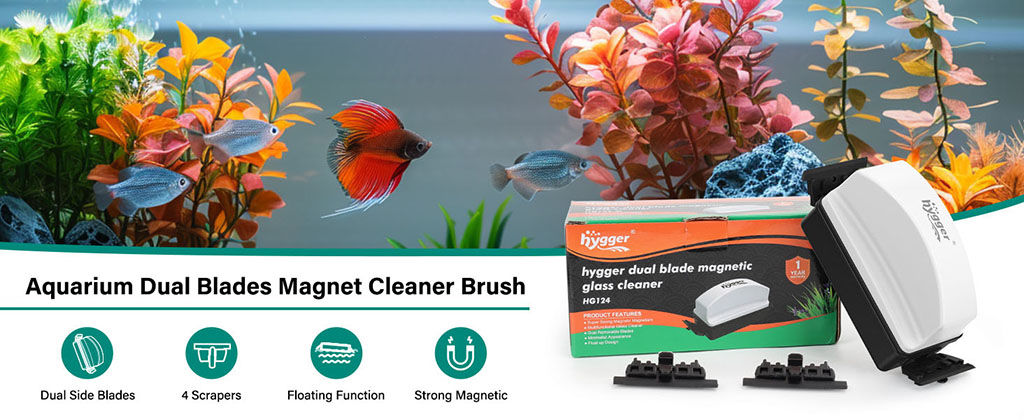
Magnetic glass cleaner for aquarium
Recommended Products For Cleaning
The hygger Dual Blade Magnetic Glass Cleaner is pivotal in ensuring that your aquarium glass remains clean regardless of the species you have in your tank, and it also aids in keeping your environment beautiful. It is a really useful tool that has sharp twin blades to clean algae and dirt, and it can be controlled with magnetic movements, so the user does not need to put his hand into the tank.
On the other hand, you can use a hygger Magnetic Fish Tank Glass Cleaner for easy cleaning of the fish tank. Due to its magnetic base, it features a simple construction whereby you can scrape off algae on the inside of the tank with wet hands. The cleaner has a float design, and its handle has a curved, wooden look grip for easy hold.
Remove Algae from Aquarium Glass
Algae are not uncommon in aquariums, but they develop as brown or green spots on the glass surface. Here are some effective methods to remove different types of algae.
Diatoms (Brown Algae)
- Light reduction: Lower the hours of lighting in your tank, as this will slow down the growth rate of your Beta fish.
- Water change: Partial water changes can help filter out other nutrients competing for bioavailability.
- Siphon: Siphon out the substrate if you notice diatoms gathering around the tank bottom.
- Algae scraper: Remove diatom patches using a spatula without applying any pressure.
Green Algae
- Reduce nutrients: DO NOT overfeed and ensure that water quality is good to control the nutrient levels.
- Increase water flow: Aquatic plants like algae grow in still water, so the water should circulate frequently.
- Algae scraper: Wipe off green algae, preferably with little force, to avoid aggressive detachment.
- Blackout: There might be a need to carry out a blackout for several days in a severe infestation to starve the algae.
Hair Algae (Blackbeard Algae)
- Manual removal: Scrape hair algae off the surface using a pair of tweezers or a toothbrush.
- Introduce algae-eating organisms: Add shrimps or snails that feed specifically on hair algae to the aquarium.
- Improve water quality: Maintain water quality and do not overfeed.
Blue-green algae (Cyanobacteria)
- Water change: To prevent the build-up of nutrients on the glass, use a larger water change to rinse them away.
- Increase water flow: Enhance water circulation to quell the progress of the cyanobacteria.
- Introduce a competitor: Introduce a plant species that has to share with cyanobacteria for some of the nutrients that it needs.
- UV sterilizer: One can use a UV sterilizer to eliminate cyanobacteria.
General Tips:
- Regular maintenance: Feed the fish in moderation, change water frequently, clean the filter, and thus reduce algae formation.
- Proper lighting: Provide sufficient light to your plants, but avoid bright light that encourages algae formation.
- Introduce algae-eating organisms: One may add shrimp, snails, or fish, which are usually known to feed on algae.
- Avoid overfeeding: Feeding your fish excessively often means that the nutrients in the water will be higher, which aids the growth of algae.
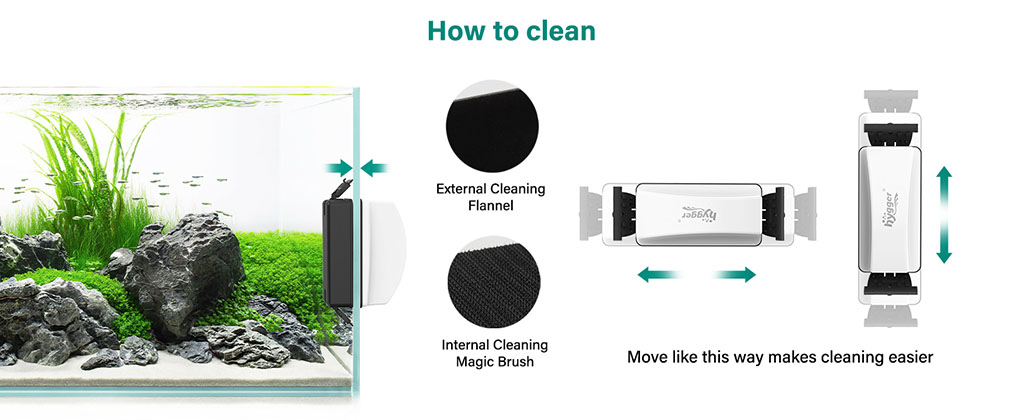
Remove algae from aquarium glass
Other Uses of Magnetic Aquarium Glass Cleaner
While primarily designed for aquarium glass, magnetic glass cleaners can also be used for other purposes.
- Windows and mirrors: They can be applied on windows and mirrors, including those that are out of easy reach or those that need a special wipe down.
- Glass surfaces: They can be utilized to clean glasses in other areas like shower doors, glass tables, or even glass crafts.
- Aquarium equipment: You can use them to make the outside of aquarium equipment which includes filters heaters and pumps comprehensible.
- Other smooth surfaces: They can also be used on other plain surfaces, such as tiles or stainless steel, but not on rough or abrasive surfaces.
Closing Remarks
These magnetic glass cleaners are very useful and effective for cleaning aquarium glass and making it clear like crystals. If you know the benefits and drawbacks, how to use them in the right manner, and ways they can be used for other purposes, you will be able to have a healthy as well as a good-looking water environment for your fish.
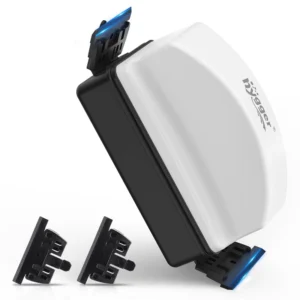
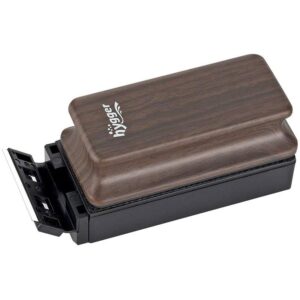
Leave a comment